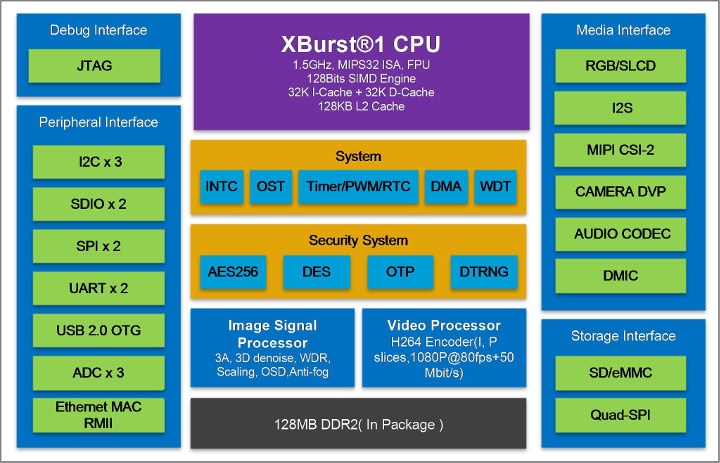Ingenic is a silicon vendor based in Beijing, China and known for its MIPS Xburst processors such as JZ4780 dual-core SoC or T10 video processor.
It’s been a while (a few years) since we last covered new processors from the company, but it appears the company launched another MIPS SoC for IoT applications last year. Meet Ingenic X1830 processor.

X1830 specifications:
- CPU – MIPS32 XBurst-1 core @ up to 1.5 GHz with SIMD engine, 32KB instruction cache, 32KB data cache, 128KB unified L2 cache
- Memory – 128MB DDR2 in package
- Storage I/F – 2x SD/eMMC controllers, and Quad SPI (QSPI)
- VPU
- H264 Encoder up to 1080p80 or 1560×1600 resolution
- JPEG compressing/decompressing up to 70Mega-pixels per second
- ISP
- 12-bit RAW or up to 24-bit RGB
- Max input resolution 2688×2048 @20fps, 1080p @60fps,720p @120fps
- 2-D and 3-D noise reduction filter, advanced demosaic, color processing, lens shading, defog, glare, static/dynamic defect pixel…
- Image post-processor (IPU)
- Data format
- Input – ARGB,RGB,NV12/NV21
- Output – ARGB,RGB,NV12/NV21,HSV
- Support 4 layers OSD
- Data format
- Display (LCD) – Up to 640×480 @ 60 Hz – TFT (RGB666) or SLCD support
- Video input – Support DVP/BT1120, 2-lane MIPI CSI2, LVDS
- Audio
- Integrated 24-bit DAC with 93dB SNR and 24-bit ADC with 92dB SNR; Sampling rate up to 96Kpbs
- I2S and DMIC interfaces
- Other Peripherals
- 10/100M Ethernet
- USB 2.0 OTG interface
- 32x independent DMA channels
- Various clocks and timers
- 3x 10-bit ADC input up to 2 Msps
- RTC (Real Time Clock)
- General-Purpose I/O ports
- 3x I2C, 2x SPI, 2x UART
- Security – Digital True Random Number Generator(DTRNG), 1024-bit OTP, AES256 encryption
- Supply Voltages
- General-purpose I/O – 1.5 ~ 3.6V
- DDR I/O for DDR2 – 1.8V ± 0.1V
- RTC I/O – 1.5V~3.6V
- EFUSE programming – 1.5V ± 10%
- Analog power supply 1 – 1.8V ± 10%
- Analog power supply 2 – 3.3V ± 10%
- Core supply – 1.3V ± 0.1V
- Package – BGA223 11 x 11 x 1.22mm, 0.65mm pitch
- Process – 28mm CMOS low power
There’s actually little public information about the processor, and it’s not even on Ingenic website. I found out about it when I was sent a link to the datasheet released in March 2019.

There aren’t any publicly available details about software or development board, but at least one product is now selling with the processor: GKD 350H (aka GameKiddy RG350 H) portable retro game console with a 3.5 ” 320×240 IPS display and running Linux. You’ll find it on Aliexpress for about $70 plus shipping, and a community has shared custom firmware for the console.
We can also see several references to X1830 in the Linux kernel mailing list, and some developers ported AWTK graphical toolkit to the latest Ingenic processor as well.
Thanks to Alexander for the tip.

Jean-Luc started CNX Software in 2010 as a part-time endeavor, before quitting his job as a software engineering manager, and starting to write daily news, and reviews full time later in 2011.
Support CNX Software! Donate via cryptocurrencies, become a Patron on Patreon, or purchase goods on Amazon or Aliexpress





Strangely, in parallel OpenWRT 19.07’s changelog mentions dropping the support for the “unmaintained XBurst platform”. So maybe they just reloaded an old forgotten processor family ?
What do you mean by “reloaded an old forgotten processor family”?
Actually there is ongoing work to homogenize and increase hardware support of ingenic’s socs. If you don’t want to lurk on the kernel mailing lists Michael Larabel wrote about it for 5.3 release here:
https://www.phoronix.com/scan.php?page=news_item&px=Linux-5.3-DRM-Ingenic-Rockchip
Also Jean-Luc covered significant progress on ingenic’s socs in release 5.4 here:
https://www.cnx-software.com/2019/11/25/linux-5-4-release-main-changes-arm-mips-risc-v-architectures/
Thanks for the links! Unfortunately I don’t know the myriad of confusing variants of the MIPS architecture. I just know I have several of them which are mutually incompatible and I don’t even know if it’s just a matter of ABI, ISA, extensions or even more than that.
When I saw this “XBurst” prominently shown on the diagram while it appears in OpenWRT’s changelog in the middle of other obsolete targets that were dropped like au1000 or ppc40x, my conclusion not knowing this particular one is that it’s among the “old” ones that are dropped from OpenWRT because not used anymore (which would not be very shocking for single-core MIPS32). Maybe that’s not the case. Maybe it was removed because considered part as the regular MIPS architecture and is not a fork anymore. But then it’s just still quite confusing. Changelog here by the way: https://forum.openwrt.org/t/openwrt-19-07-0-first-stable-release/52186
Maybe it’s just because there aren’t many routers based on XBurst processors. If most devices are tablets or gaming consoles, there’s little need for OpenWrt on this type of hardware.
Maybe indeed.
Possibly a target for retrobsd?
nah, that targets microcontrollers. this is more of a CPU.
It already runs Linux. The manufacturer of the this handheld (gkd350h) has ported openDingux [1]. openDingux was originally developed for the gcwZero with jz4770. Differences that I know of between the jz4770 and the x1830 is that x1830 doesn’t have any 3d-accelerator (and hence rely on software rendering) and a different IPU. Unfortunately the gkd350h manufacturer didn’t implement support for the new IPU, so it instead relies on software scaling of the emulated systems to fit the display. Luckily the x1830 has a lot of more processing power than the jz4770. You can even overclock it to 1.9GHz without noticeable heating. So with that in mind for the software scaling isn’t really a limitation in this usecase, unless you would want save cpu-cycles for emulating more complex systems.
Unfortunately the linux source code for this handheld is not available. So we don’t know how many changes were required.
[1] https://github.com/opendingux/
There is a kernel tree at http://git.ingenic.com.cn:8082/gerrit/kernel/kernel-3.10 that supports this SoC along with 4775, 4780, m200, x1000, x1520, x1630 and x1830. There are also references to a 4.4.93 kernel but I couldn’t find that one, maybe they abandoned the port to later kernels again.
It also appears that all X1xxx and Tx0 chips are closely related, with mostly incremental changes to the video encoder unit for use in cameras, the CPU clock frequency and the amount of integrated RAM.
It’s going to be interesting if they ever come out with the X2000 chip, which is said to be based on a mips64r5 XBurst2 core instead of the XBurst1.
Apparently it was not expected to be public, it says 404 now. And well, 3.10 was EOLed quite a few years ago now. I hope at least they are not maintaining their own!
Could it be that this snapshot on their ftp server is the same, even though its not advertised as that?
ftp://198.13.102.99/ingenic_support/X1000_X1000E_X1500/01_SW/00_Board-Level_Consolidation_Version/Kernel3.10.14_X1000_New_Version/08_ingenic-linux-kernel3.10.14-x1000-v9.0-20191212/ingenic-linux-kernel3.10.14-x1000-v9.0-20191212.tar.bz2
Also here is the programming manual:
https://jz47xx.github.io/manuals/X1830_pm.pdf
As a sidenote, it would seem that it doesn’t support hw scaling, despite what I wrote above to Diego.
3.10.14 ? Seriously ? This is criminal. It was already missing 5700 fixes two years ago when 3.10 was EOLed. Since then we’ve had thousands more and hundreds of new vulnerabilities. There are probably around 1000 unfixed important security issues and 8-10000 unfixed bugs in this kernel. In short there is zero chance of stability on this thing. Guys, please don’t touch that, it’s worse than radioactive waste!